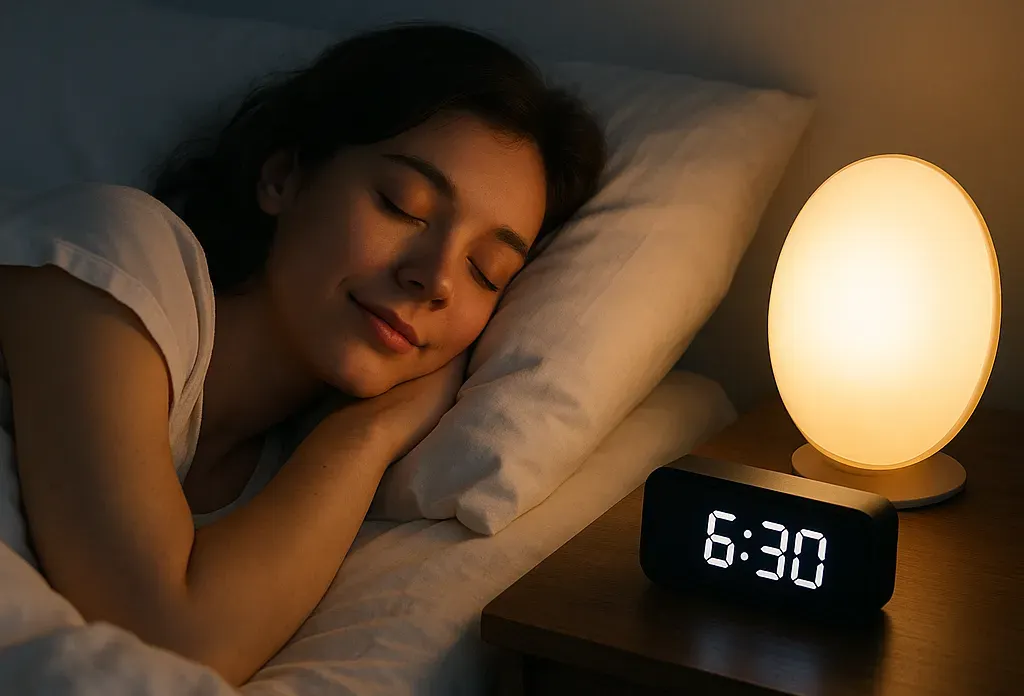
Introduction
The quality of your sleep directly impacts your physical health, emotional well-being, and cognitive function. Yet in our busy, screen-filled lives, many of us neglect the importance of a proper bedtime routine.
This guide will walk you through creating the perfect evening ritual to transform your sleep quality and help you wake up refreshed every morning.
Why Your Bedtime Routine Matters
A consistent bedtime routine signals to your body that it’s time to wind down, triggering the release of sleep hormones like melatonin while reducing stress hormones like cortisol. Research shows that people with consistent bedtime routines fall asleep faster and experience fewer nighttime awakenings.
According to a 2018 study published in the Journal of Sleep Research, participants who followed a regular bedtime routine reported a 50% improvement in sleep quality within just one week.
Another study from the National Sleep Foundation found that people with consistent bedtime routines fall asleep an average of 7 minutes faster and experience 30% fewer nighttime awakenings.
Step 1: Set a Fixed Bedtime and Wake-up Time
Timing is Everything
The foundation of any effective sleeping routine is consistency. Try to go to bed and wake up at the same time every day—even on weekends. This helps regulate your body’s internal clock (circadian rhythm) and can help you fall asleep and wake up more easily.
Your circadian rhythm isn’t just about sleep—it influences countless biological processes including hormone regulation, body temperature, and even digestion. When you keep irregular hours, these systems become confused, making quality sleep more difficult to achieve.
Pro Tip: Work backward from your required wake-up time, allowing 7-9 hours for sleep, to determine your ideal bedtime. For example, if you need to wake up at 6:30 AM, aim to be asleep (not just in bed) between 9:30-11:30 PM.
Consistency Tools:
- Use sleep tracking apps to analyze your optimal sleep duration
- Set bedtime reminders 60 minutes before your target bedtime
- Use a sunrise alarm clock for more natural awakening
Struggling to maintain a consistent schedule? Spryfuel’s specialized rhythm-setting sound program can help reset your body clock and make consistency easier.

Step 2: Create a Wind-Down Period (90 Minutes Before Bed)
Begin Dimming the Lights
Gradually reduce lighting throughout your home as bedtime approaches. Lower light levels signal to your brain that it’s time to produce melatonin, the hormone that regulates sleep.
The science behind this is fascinating: your retinas contain special cells called intrinsically photosensitive retinal ganglion cells (ipRGCs) that detect light and directly signal your brain’s master clock. Blue and bright white light especially suppress melatonin production, while warm, dim light allows natural melatonin release.
Digital Sunset Implementation:
- Use smart bulbs that automatically dim and shift to warmer tones
- Wear blue-light blocking glasses after sunset (especially if you must use screens)
- Replace bright overhead lights with warm table lamps in the evening
- Consider using amber or red night lights for bathroom trips
Digital Sunset
Implement a “digital sunset” by turning off all electronic devices at least 60-90 minutes before bedtime. The blue light emitted from screens disrupts your natural sleep-wake cycle.
Expert Tip: Can’t fully disconnect? At minimum, enable Night Shift/Night Mode on all devices, which reduces blue light emission. Better yet, try one of Spryfuel’s specially designed frequency programs that can help counteract some of the stimulating effects of necessary screen use. Learn more about these specialized programs here
Step 3: Engage in Relaxing Activities (60 Minutes Before Bed)
Choose calm, screen-free activities like:
- Reading a physical book (not an e-reader)
- Taking a warm bath or shower
- Gentle stretching or yoga
- Meditation or prayer
- Journaling
Spotlight on Bedtime Reading:
Reading before bed has been shown to reduce stress by up to 68% according to University of Sussex research. However, content matters—choose fiction, poetry, or light non-fiction rather than work-related material or suspenseful stories that keep you turning pages.
The Power of Temperature Regulation:
A warm bath or shower 60-90 minutes before bed helps trigger sleep onset through a process called thermal regulation. When you exit the warm water, your core body temperature begins to drop, mimicking the natural temperature decrease that happens as you fall asleep.
Sound Therapy During Relaxation Activities:
Enhance any of these relaxation activities by simultaneously using Spryfuel’s specially designed bedtime frequency programs. Unlike meditation apps that require your active attention, Spryfuel’s passive sound therapy works in the background while you enjoy your wind-down activities. Try the relaxation bundle tonight

Step 4: Prepare Your Sleep Environment (30 Minutes Before Bed)
Optimize Your Bedroom
Transform your bedroom into a sleep sanctuary:
- Temperature: Keep it cool (65-68°F)
- Sound: Minimize noise or use white noise
- Light: Make it as dark as possible
- Comfort: Ensure your mattress and pillows are supportive
- Scent: Consider calming essential oils like lavender or chamomile
The Science of Sleep Environment:
The way your bedroom is set up actually affects how you cycle through different sleep stages. If your room’s too hot, it messes with your REM sleep, and even a tiny bit of light can cut your melatonin (your sleep hormone) in half. What’s crazy is that sounds as soft as a whisper can fragment your sleep, even if they don’t wake you up completely.
Bedroom Optimization Tips:
- Invest in blackout curtains or a quality sleep mask
- Use a white noise machine to mask disruptive sounds
- Consider a cooling mattress pad for temperature regulation
- Replace pillows every 1-2 years for optimal support
- Remove electronics that emit light (cover indicator lights if necessary)
Prepare for Tomorrow
Reduce morning stress by laying out clothes, preparing lunch, or making a to-do list for the next day. This “mental offloading” prevents racing thoughts about tomorrow’s responsibilities from keeping you awake.
Step 5: Practice Mind-Calming Techniques (15 Minutes Before Bed)
Try Sound Frequency Therapy
One of the most effective recent innovations in sleep science is the use of frequency-based sound therapy. Programs like Spryfuel use specific sound frequencies that help synchronize brain hemispheres and induce the brainwave patterns associated with deep relaxation and sleep.
How Frequency Therapy Works:
Your brain naturally produces electrical patterns at different frequencies depending on your state:
- Beta waves (14-30 Hz): Active, alert thinking
- Alpha waves (8-13.9 Hz): Relaxed awareness
- Theta waves (4-7.9 Hz): Deep relaxation, light sleep
- Delta waves (0.5-3.9 Hz): Deep sleep
Spryfuel’s sleep programs use a scientifically calibrated combination of frequencies that guide your brain from beta to alpha, then theta, and ultimately delta—essentially creating a neural “pathway” to deep sleep. Just 10-15 minutes of listening can dramatically improve your ability to fall asleep.
Unlike meditation apps that require active participation, frequency therapy works passively—you simply listen and let the frequencies do the work. This makes it particularly valuable for those who find traditional meditation challenging. Experience the difference tonight for free with Spryfuel’s sleep program
Breathing Exercises
Simple breathing techniques can calm your nervous system:
- 4-7-8 breathing method: Inhale for 4 counts, hold for 7, exhale for 8
- Box breathing: Inhale for 4, hold for 4, exhale for 4, hold for 4
- Deep diaphragmatic breathing: Focus on expanding your belly rather than chest
The Vagus Nerve Connection:
These breathing techniques work by stimulating your vagus nerve—the main component of your parasympathetic nervous system (your “rest and digest” mode). When activated, it reduces heart rate, blood pressure, and stress hormones while increasing digestive activity and promoting relaxation.
Step 6: Adopt a Comfortable Sleep Position (5 Minutes Before Bed)
The position you sleep in affects your breathing, spinal alignment, and overall sleep quality:
Side Sleeping (Best for Most People):
- Best for reducing snoring and sleep apnea
- Helps clear brain waste through the glymphatic system
- Ideal during pregnancy (left side specifically)
- Pillow recommendation: Slightly thicker pillow to keep spine aligned
Back Sleeping:
- Ideal for spinal alignment and preventing wrinkles
- Worst for snoring and sleep apnea
- Pillow recommendation: Thinner pillow to avoid neck strain
Stomach Sleeping:
- Generally least recommended due to neck strain
- Can reduce snoring for some people
- Pillow recommendation: Very thin pillow or none at all
Position Modification Tips:
- Use a body pillow for side sleeping to reduce pressure on hips and shoulders
- Place a small pillow under your knees when back sleeping to reduce lower back pressure
- If you must sleep on your stomach, place a thin pillow under your pelvis to reduce spinal curvature
Experiment to find what works best for you. If you find yourself tossing and turning, Spryfuel’s deep relaxation program can help your body settle into a comfortable position more quickly. [Try the deep relaxation program] [AFFILIATE LINK]
[IMAGE SUGGESTION: Diagram showing proper alignment for the three main sleeping positions with recommended pillow placements]
Step 7: Use Sleep-Inducing Techniques (In Bed)
If you’re not asleep within 20 minutes:
Progressive Muscle Relaxation:
Tense and then relax each muscle group, starting from your toes and working up to your head. This reduces physical tension and helps quiet your mind.
Visualization Techniques:
Picture yourself in a peaceful, safe place in great detail. Engage all your senses: what do you see, hear, smell, feel, and taste in this place? This powerful technique distracts from anxious thoughts while inducing relaxation.
The Military Method:
This technique, reportedly developed by the U.S. military, helps people fall asleep in under 2 minutes:
- Relax your entire face, including tongue and jaw muscles
- Drop your shoulders and let your hands fall to the side of your body
- Exhale, relaxing your chest
- Relax your legs, thighs, and calves
- Clear your mind for 10 seconds by imagining a relaxing scene
- If this doesn’t work, try saying “don’t think” repeatedly for 10 seconds
When to Consider Extra Help
If you’ve established a consistent bedtime routine and still struggle with sleep, it might be time to try specialized solutions. Thousands have found relief with Spryfuel’s sleep frequency programs, which use scientifically calibrated sound waves to induce deep relaxation and sleep.
Beyond Basic Programs:
Spryfuel offers specialized programs for specific sleep issues:
- Trouble falling asleep (sleep onset insomnia)
- Difficulty staying asleep (sleep maintenance insomnia)
- Early morning awakening
- Anxiety-related sleep disturbances
- Jet lag and shift work adjustments
Unlike medication, these programs have no side effects and work naturally with your brain’s own mechanisms. Many users report improvements starting from the very first night. Try Spryfuel tonight for free and transform your sleep

Success Stories
“After trying everything from melatonin to prescription sleep aids, I was skeptical about sound therapy. But after just three nights of using Spryfuel’s sleep program as part of my bedtime routine, I was falling asleep within 15 minutes instead of my usual 1-2 hours. The difference in how I feel the next day is incredible.” – Sarah M.
“As someone with ADHD, my mind often races at bedtime. Spryfuel’s frequency therapy helps quiet my thoughts faster than anything else I’ve tried. It’s now an essential part of my nightly routine.” – Michael T.

Conclusion
The perfect bedtime routine doesn’t have to be complicated—it just needs to be consistent. By following these seven steps and incorporating sound frequency therapy from Spryfuel, you can transform your sleep quality and wake up feeling truly refreshed.
Remember that building new habits takes time. Start by implementing just one or two elements of this routine, then gradually add more as they become natural parts of your evening. Within weeks, you’ll likely experience noticeably improved sleep quality and daytime energy levels.
Ready to experience the transformative power of a proper bedtime routine enhanced with sound frequency therapy? Try Spryfuel risk-free for 7 days and discover what truly restful sleep feels like.

